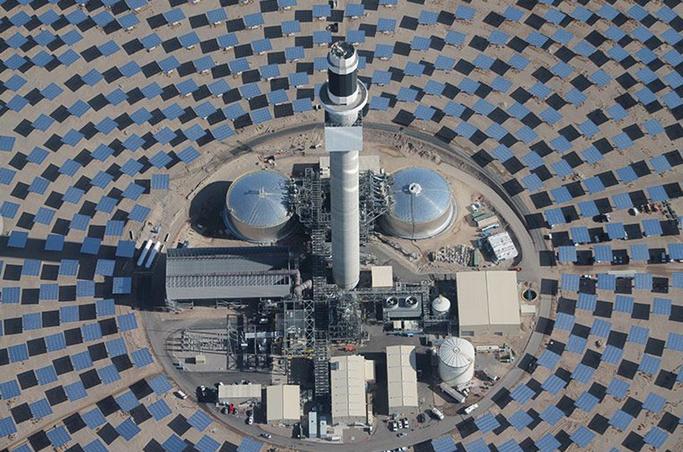Concentrated solar power developer Solar Reserve is putting the finishing touches on the solar tower and storage for its 110MW Crescent Dunes power plant in Tonopah, Nevada, just three hours from Las Vegas. The company's been in commission mode since February 2014, when US Energy Secretary Ernest Moniz and the VIP investors from Google and NRG celebrated the opening of the rival Ivanpah Solar Electric Generating System 210 miles away in the California. Ironically, although Ivanpah was the largest concentrated power plant in the world, its new power tower technology — without storage — was already obsolete.
That's because lot has changed in the world of solar energy, which has made Crescent Dunes — one-third the size of Ivanpah — a major evolution in concentrated solar power technology.
Crashing PV prices
In 2008 when Ivanpah's contracts were signed, power from its technology was still cheaper than utility-scale PV. Unlike solar photovoltaic panels, which convert sunlight directly into electricity, Ivanpah's 100,000s of heliostats focused intense sunlight on a power tower to heat water and create steam to spin turbines and generate electricity.
But then China massively overbuilt solar module factories and flooded the world with low cost solar panels. According to the DOE, the price for utility-scale PV dropped from about 21 cents per kilowatt-hour in 2008 to 11 cents in 2013. Recently, some PPAs (project purchase agreements) for large-scale PV have fallen to 6 cents. Since PV has about 10 times the scale of CSP in terms of deployment and PV prices are still falling, it will be impossible for traditional CSP to survive.
Crescent Dunes has become more important than Ivanpah because its 10 hours of molten salt storage will deliver power to Las Vegas between noon and until 2am every day, long after sunset has shut Ivanpah down.“We'll start commissioning the steam turbine soon,” Tom Georgis, the head of development told RenewEconomy. “We'll be at full commercial delivery by early July."
Dispatchable baseload power
So although concentrated solar power is more expensive than solar panels and wind turbines, advocates like Solar Reserve CEO Kevin Smith say it has a major advantage over other renewables: the ability to time-shift power output by storing energy. After all, as states like Nevada and California race to adopt renewable energy, one of the biggest drawbacks is intermittency — the fact that most solar and wind plants only produce power when the sun is shining or the wind is blowing.

The storage technology is relatively straightforward. Sunlight focused on the top of a 540-foot tower heats molten salt to more than 1,000°F, and that hot liquid is transferred to a storage tank, where it retains most of its heat. Regardless of the time of day, when electricity is needed, the molten salt can be used to heat water, creating steam to turn turbines, and generate electricity.
Solar Reserve’s molten salt storage is one of the key components in the evolution of a modern, multi-souce, flexible grid. CEO Kevin Smith said executives from at least 20 countries have visited Crescent Dunes to inspect the storage technology and are eager to see it when it finally comes online.
While new concentrated solar development is coming to a standstill in the United States, it continues to thrive overseas. Of the 23 concentrated solar projects with storage that came online by the end of last year, just one was in the United States, according to a report from the Concentrating Solar Power Alliance. Twenty-one of those projects were in Spain, which until last year offered a financial incentive specifically for concentrated solar.
Which bring us to the next evolution of CSP technology: countries are starting to build hybrid solar power plants that combine both technologies. The PV reduces the cost of the energy produced, but the storage balances PV's intermittency.
Solar Reserve's South African Hybrid solar plant
SolarReserve, along with Saudi Arabian ACWA Power, have been given the go-ahead by the South African Department of Energy to build the Redstone 100 MW solar power and energy storage project. It will be built next to Solar Reserves' 75MW Lesedi and 96MW Jasper PV projects, already up and running. Together, the three comprise the world's first combined CSP and PV solar park, with a total of 271MW of generating capacity. The 100 MW Redstone addition is expected to come online in 2018, according to SolarReserve.
The plant's thermal energy-storage system will supply baseload power similar to conventional coal, oil, nuclear or natural gas-fired power plants, without the emissions and fuel cost, SolarReserve Chief Executive Officer Kevin Smith said.
The Saudi firm said this year that the combination of solar tower and storage and solar PV will enable baseload power to be delivered to the Middle East and Africa at a lower cost than conventional fossil fuels.
Is molten salt storage as important as lithium battery storage?
Photos: various, Solar Reserve


